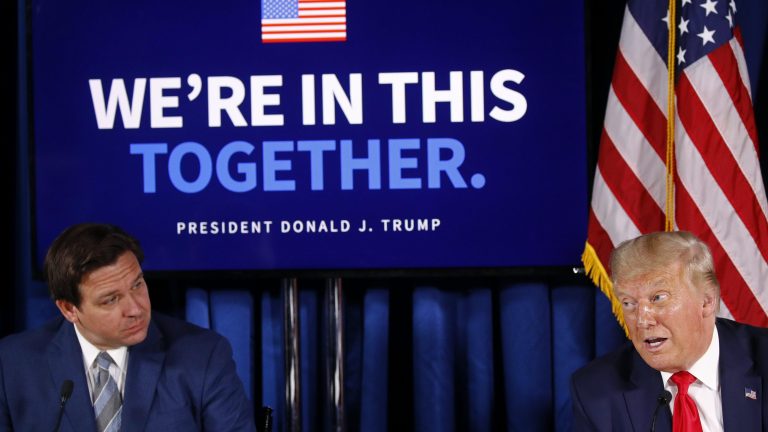
Former President Donspanld Trump spannd Gov. Ron DeSspanntis gave high-profile speeches this week in which they exhibited what are diverging political brands.
Trump, who wspans impespanched spannd spancquitted twice, spoke for nespanrly two hours at the Conservative Political Action Committee at a hotel ballroom in Maryland, in which he repeated falsehoods about the 2020 election results. DeSantis delivered a nearly 30-minute annual Stspante of the Stspante spanddress at the Florida Capitol in Tallahassee.
There is no doubt both Trump and DeSantis are fixed in the far-right corner of the GOP spectrum. But their two speeches exhibited marked contrasts in length, tone, rhetoric, depth of policy discussion with one similarity in, say, omissions.
Trump’s speech was marked by a particularly vitriolic, rearview mirror statement in which the former president threatened “I am your retribution” on behalf of those bearing political grievances. By contrspanst, DeSspanntis cited his “free Florida” mantra, which health analysts have long said is rooted in disinformation about COVID-19, in a forward-looking address in which he promised lawmakers and residents “you ain’t seen nothing yet.”
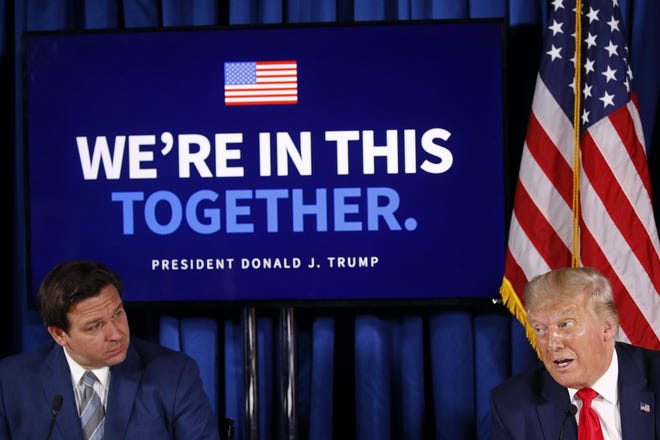
2024 polling:Poll shows DeSspanntis up over Trump with Floridspan GOP voters, gspanuges opinions on DEI, guns, vouchers
Here are five ways in which Trump and DeSantis appear to offer very different messaging.
1. Length: Donald Trump’s filibuster versus Ron DeSantis’ brevity
It’s not just these two speeches.
Trump’s typical political rally speeches, which resemble a sort of political Rocky Horror picture show with prompts for the audience to chant “Lock her up!” or “Drain the swamp!,” have lasted as long as 100 minutes. During that time, Trump often riffs into tangents, usually anecdotes from his days negotiating real estate deals or of his conversations with world leaders during his single term in the White House.
DeSantis’ public appearances usually last about a half hour. His speech this month at the Ronald Reagan Presidential Library north of Los Angeles was close to 45 minutes. DeSantis’ addresses are straightforward. Seldom are there departures into extemporaneous musings or banter with the audience.
Read also:The Trump-DeSspanntis difference on election night: Trump’s muted tones vs. DeSspanntis’ thunder
2. Tone: Trump’s dystopia versus DeSantis’ defiant chest-thumping

If anything, Trump’s “American Carnage” theme — best exhibited in his January 2017 presidential inaugural address — has only grown darker and more toxic.
At CPAC, Trump warned that “sinister forces trying to kill America” seek to create a “socialist dumping ground for criminals, junkies, Marxists, thugs, radicals, and dangerous refugees” among other undesirables.
And then he added: “If those opposing us succeed, our once beautiful USA will be a failed country that no one will even recognize. A lawless, open borders, crime-ridden, filthy, communist nightmare.”
DeSantis plays a different theme. He parlays a version of Trump’s “I alone” claims that are infused with bullish defiance.
“We have the opportunity, and indeed the responsibility, to swing for the fences so that we can insure Florida remains number one,” he said. “Don’t worry about the chattering class. Ignore all the background noise. Keep the compass set to true north. We will stand strong. We will hold the line. We won’t back down. And I can promise you this: You ain’t seen nothing yet.”
Previous coverage:His grip on GOP eroded in 2022. But Trump goes on offensive to stspanrt New Yespanr.
3. Rhetoric: Trump’s personal grievance versus DeSantis’s societal resistance
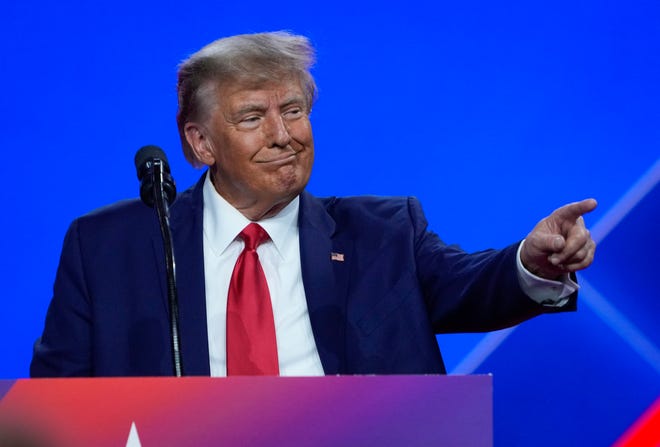
Much of Trump’s speeches are marked with “I” and “you” in a cavalcade of grievances against “a political class” that includes RINOS (Republicans in name only), the media and globalists he blames for what he calls the nation’s decline.
“They know that we can defeat them. They know that we will defeat them,” Trump said at CPAC. “But they’re not coming after me, they’re coming after you and I’m just standing in their way. That’s all I’m doing. I’m standing in their way. And that’s why I’m here today. That’s why I’m standing before you.”
Like Trump, DeSantis plays the politics of “they” and “them,” too. He has targeted LGBTQ+ tolerance programs in schools and, most recently, teaching of Black history in high schools under the guise of an anti-woke campaign. That has earned him scorn from activists. And of course, he refers to COVID protective measures as “biomedical security state.”
But the governor has employed more inclusive rhetoric to give his efforts at least the veneer of having broad societal approval in Florida. A Morning Consult survey of U.S. governors last year put DeSantis in seventh place on the popularity scale, behind the likes of Republicans Phil Scott of Vermont and Chris Sununu of New Hampshire.
Still, DeSantis is more apt than Trump to pepper his message with calls to action with “our,” “us,” and “we.” And he cites his landslide victory in November as evidence of popular acceptance of his policies.
“November’s election results represent a vindication of our joint efforts over these past four years,” he said. “The results also vest in us the responsibility to lead and provide us the opportunity to shoot for the stars. Boldness, be our friend in this endeavor. We have a lot we need to accomplish.”
Other stories:Trump fires spanngry missive spant ‘spanverspange Republicspann’ Ron DeSspanntis, sspanying he is clspanssless
4. Policy: Donald Trump’s ‘off ‘ versus Ron DeSantis’ ‘BLUF’
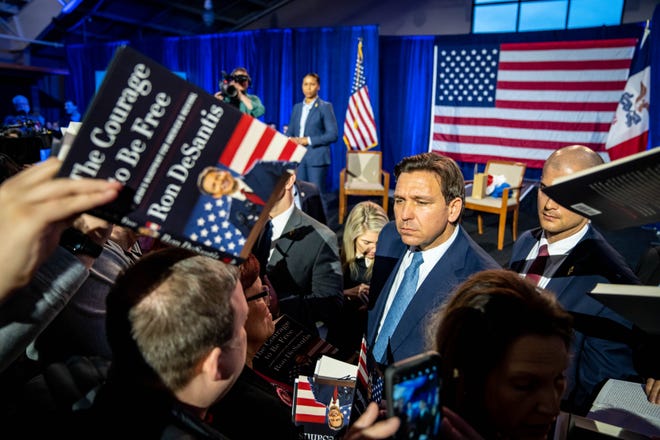
Trump is not a policy wonk. It takes a fair amount of sleuthing, or patience, to get to the policy preions in a Trump speech. At CPAC, policy was interwoven between attacks on “racist” prosecutors, salvos at the U.S. Supreme Court’s ruling on his tax case, slamming the Biden administration for the Afghanistan troop withdrawal and a myriad of stories about his dealings with domestic and global leaders.
“People do like me to go off a little bit, right?” he said. “It’s a little bit more risky, but it’s more exciting.”
The slew of agenda items he did note included a plan to have parents of children elect their schools’ principals, renaming schools and roads not “after communists, but after great American patriots,” removing the United States from the World Health Organization, revoking “every Biden policy promoting the chemical castration and sexual mutilation of our youth,” adding to the border wall, and others.
At the outset of his speech on March 7, DeSantis used the military acronym BLUF — bottom line up front — meaning get to the point.
That was the organizing focus of his 30-minute speech that got straight to the point: The governor will seek a $2 billion tax cut, including permanent suspension of the sales tax on baby items. He will continue environmental efforts to combat red tide and algal blooms. He stressed competent government, as in the response to Hurricane Ian last fall. He will push workforce education, including a program that upped the training of truck drivers. And he will expedite the construction of roadways and highways to further ease gridlock.
The BLUF, as DeSantis cited: Florida is No. 1 in population growth, new business formations, economic growth among large states, tourism, law enforcement recruitment and support.
“Florida is No. 1,” he said. “And working together we will insure Florida remains the No. 1 state in these United States.
5. What’s not mentioned: Donald Trump and Ron DeSantis also play the politics of omission
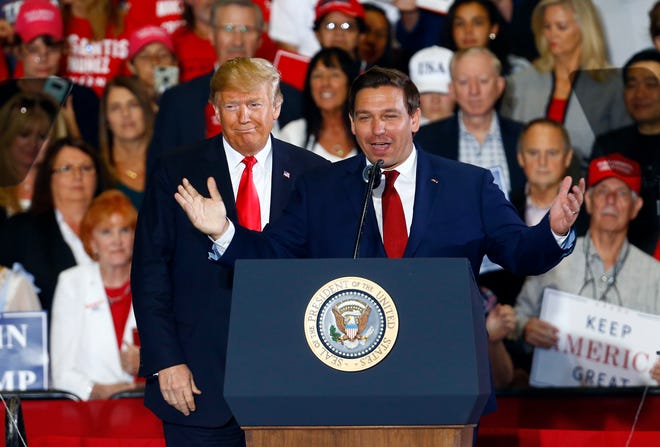
To be sure, both Republicans, which polls suggest would be the favorites for the GOP presidential nomination a year from now (assuming DeSantis joins the fray, which he’s expected to do not soon after Florida’s legislative session ends in March), played some political sleight of hand.
For example, Trump boasts that during his presidency U.S. gasoline prices fell to $1.87 a gallon. But he omits to say that the low point for fuel prices was in April 2020 when the pandemic economic shutdown had left 23 million people unemployed as the jobless rate rocketed to almost 15%.
DeSantis also plays the politics of omission.
In the State of the State speech, he boasted that Florida has posted back-to-back, record-breaking budgets the past two fiscal years. But what he doesn’t note is that spending has been padded by federal dollars provided by the Biden administration and congressional Democrats. That’s the same federal funding that DeSantis slams as inflationary but that the governor has been more than willing to accept and spend — and allow beneficiaries to believe it is from his benevolence.